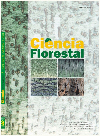
|
Ciência Florestal
Centro de Pesquisas Florestais - CEPEF, Departamento de Ciências Florestais - DCFL, Programa de Pós Graduação em Engenharia Florestal - PPGEF
ISSN: 0103-9954
EISSN: 0103-9954
Vol. 18, No. 1, 2008, pp. 75-84
|
 Bioline Code: cf08007
Bioline Code: cf08007
Full paper language: English
Document type: Research Article
Document available free of charge
|
|
|
Ciência Florestal, Vol. 18, No. 1, 2008, pp. 75-84
| en |
Repellence of natural and synthetic substances to the consuming wild mammals of Araucaria angustifolia (Bertol.) Kuntze seeds at field sowing
de Arruda, Guilherme O. S. Ferraz; Casa, Ricardo Trezzi & Fleig, Frederico Dimas
Abstract
This work aimed at testing some natural and synthetic substances, not phytotoxics and not lethal for
the fauna, to verify the repellence action for the consuming wild animals of Parana-Pine seeds, in two direct
sowing experiments in the field. In experiment I, there was the direct application of the treatments in the
Parana-Pine seeds and, in the experiment II, there was the application of the treatments only in the surface of
the plantation hollows, after the sowing of Parana-Pine seeds. The Parana-Pine seeds and the treatments were
prepared at Laboratory of Center of Agroveterinary Sciences, University of Santa Catarina State, at Lages
city, Brazil. The experiments were carried to a native-antropic field area at Lages city. It was adopted the
experimental design of randomized blocks for both experiments. Experiment I was composed of 15 treatments, 10 seeds per treatment, with 4 replications, and experiment II was composed of 11 treatments, 10
seeds per treatment, with 4 replications. The tested substances, isolated or in mixtures, were: fruit of red
pepper, root of parsley, stem and leaf of wormwood herb, lemon scented gum essential oil, linseed oil, castor
bean oil, rosin, copper oxychloride, copper sulphate, sulphur, látex ink and calcium lignosulfonate. Through
the periodic inspections, during 167 and 165 days respectively for the experiments I and II, data were
collected and organized through the attacked and not attacked Paraná-Pine seeds, being submitted to
statistical analysis later. The predation rates were considered high for both experiments: 86,7% in experiment
I and 84,3% in experiment II. In the experiment with treated Parana-Pine seeds, the longer time for the
beginning of the predation was 104 days after the sowing, while, in the experiment with treatment in the
environment (hollows), it was 64 days after the sowing. Solution of rosin and alcohol + lemon scented gum
oil, applied in the seeds, presented potential for reduction of the predation level. The treatments with linseed
oil presented changeable behaviors, equally to the treatments with latex ink, in the experiment with treated
Parana-Pine seeds. In the experiment with treated hollows, the lignosulfonate of calcium in mixture with
extracts of pepper, with root of parsley and with wormwood herb presented significant effect of reduction on
the predation. The solution of linseed with red pepper extracts and with root of parsley extract also had
significant effect for reduction of the predation of these seeds, in the experiment with treated hollows.
Keywords
repellents; rodents; Parana-Pine
|
| |
| pt |
Repelência de substâncias naturais e sintéticas aos mamíferos silvestres consumidores de sementes de Araucaria angustifolia (Bertol.) Kuntze em semeadura no campo
de Arruda, Guilherme O. S. Ferraz; Casa, Ricardo Trezzi & Fleig, Frederico Dimas
Resumo
Este trabalho objetivou testar algumas substâncias naturais e sintéticas, não-fitotóxicas e não-letais
aos animais silvestres consumidores de pinhões, em dois experimentos com semeadura direta no campo. No
experimento I, os tratamentos repelentes foram aplicados diretamente nos pinhões e, no experimento, II
foram aplicados somente na superfície das covas, logo após a semeadura de pinhões. Os pinhões e os
tratamentos foram preparados em Laboratório do Centro de Ciências Agroveterinárias (UDESC), Lages, SC.
Os experimentos foram instalados numa área de campo nativo-antrópico, localizada em Lages, SC e adotouse
o delineamento experimental de blocos casualizados para ambos. O experimento I teve 15 tratamentos,
dez pinhões por tratamento, com quatro repetições, e o experimento II teve 11 tratamentos, dez pinhões por
tratamento, com quatro repetições. As substâncias testadas, isoladamente ou em misturas, sob forma de
extratos, óleos e soluções, foram à base de fruto de pimenta vermelha, raiz de salsinha, parte aérea de losna,
óleo essencial de eucalipto, óleo de linhaça, óleo de mamona, breu, oxicloreto de cobre, sulfato de cobre,
enxofre, tinta látex pva e lignosulfonato de cálcio. Por meio de vistorias periódicas ao longo de 167 e 165
dias respectivamente para os experimentos I e II, os dados foram coletados e organizados quanto ao número
de pinhões predados e não-predados, sendo posteriormente submetidos à analise estatística. Os índices de
predação foram elevados para ambos os experimentos: 86,7% no experimento I e 84,3% no experimento II.
No experimento com pinhões tratados, o período de tempo mais longo verificado para o início da predação
foi de 104 dias após a semeadura e no experimento com tratamento no ambiente (covas), foi de 64 dias.
Solução de breu e álcool + óleo de eucalipto, aplicados nos pinhões, apresentou potencial para redução do
nível de predação. Os tratamentos com óleo de linhaça apresentaram comportamentos variáveis, igualmente
aos tratamentos com tinta látex, no experimento com pinhões tratados. No experimento com tratamentos nas
covas, o lignosulfonato de cálcio combinado individualmente com extratos de pimenta, raiz de salsinha e
losna, apresentou efeito significativo de redução da predação. A solução de linhaça, com extratos de pimenta
vermelha e com o extrato de raiz de salsinha, também teve efeito significativo para redução da predação de
pinhões, no experimento com tratamento nas covas.
Palavras-chave
repelentes; roedores; araucária
|
| |
© Copyright 2008 - Ciência Florestal
Alternative site location: http://cascavel.ufsm.br/revistas/ojs-2.2.2/index.php/cienciaflorestal/index
|
|
